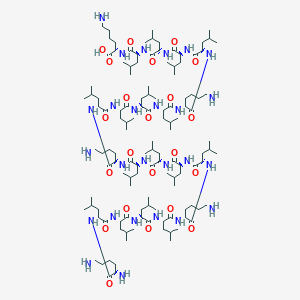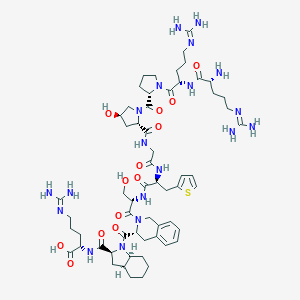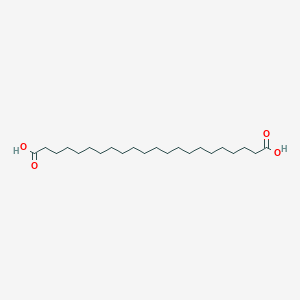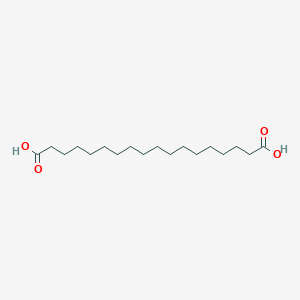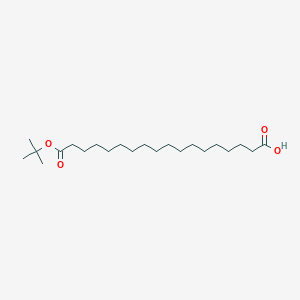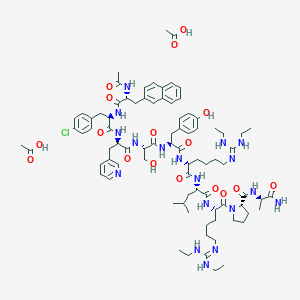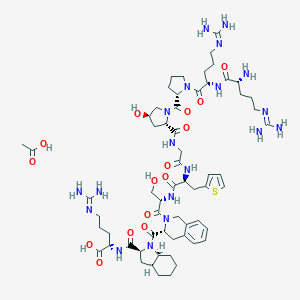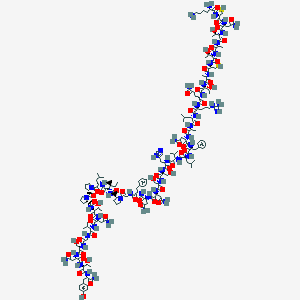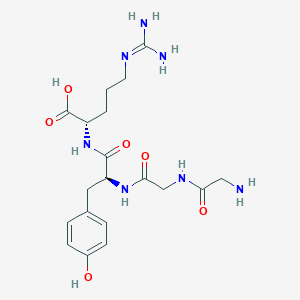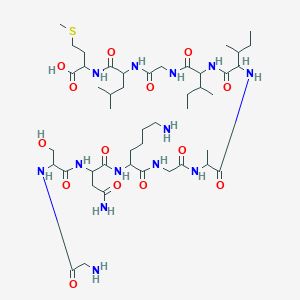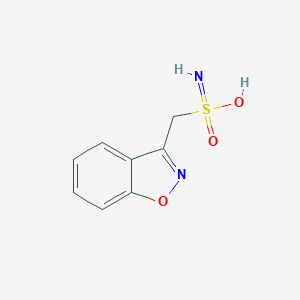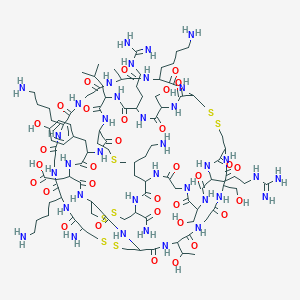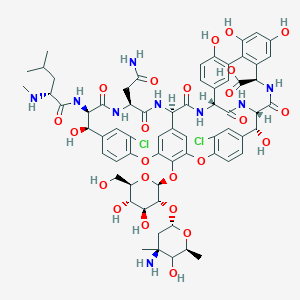
Vancomycin
Overview
Description
Vancomycin is a glycopeptide antibiotic primarily used to treat severe bacterial infections caused by Gram-positive bacteria, including methicillin-resistant Staphylococcus aureus (MRSA) and Clostridium difficile . It was first isolated from a soil sample in Borneo in 1956 and has since become a critical tool in combating antibiotic-resistant infections .
Mechanism of Action
Target of Action
Vancomycin, a glycopeptide antibiotic, primarily targets the D-alanyl-D-alanine (D-Ala-D-Ala) terminus of cell wall precursor units in bacteria . This terminal sequence plays a crucial role in bacterial cell wall synthesis . The antibiotic is particularly effective against severe bacterial infections such as MRSA (methicillin-resistant Staphylococcus aureus) infections .
Mode of Action
This compound operates by inhibiting cell wall synthesis in bacteria . It binds to the D-Ala-D-Ala terminus of cell wall precursor units, preventing their incorporation into the cell wall . This action weakens the bacterial cell wall, leading to cell lysis and death . There is also evidence that this compound alters the permeability of the cell membrane and selectively inhibits ribonucleic acid synthesis .
Biochemical Pathways
The primary biochemical pathway affected by this compound is the synthesis of the bacterial cell wall. By binding to the D-Ala-D-Ala terminus of cell wall precursor units, this compound prevents the transglycosylation step in peptidoglycan polymerization . This action disrupts the formation of the bacterial cell wall, leading to cell lysis and death .
Pharmacokinetics
In patients with normal creatinine clearance, this compound has an α-distribution phase of ∼30 min to 1 hour and a β-elimination half-life of 6–12 hours. The volume of distribution is 0.4–1 L/kg . The binding of this compound to protein has been reported to range from 10% to 50% .
Result of Action
The molecular effect of this compound’s action is the disruption of the bacterial cell wall, which leads to cell lysis and death . On a cellular level, this compound causes changes in the permeability of the cell membrane and selectively inhibits ribonucleic acid synthesis . This results in the inhibition of bacterial growth and proliferation.
Action Environment
Environmental factors can influence the action, efficacy, and stability of this compound. For instance, regional variations and climate types (temperate and monsoon climates) have been found to significantly affect the resistance rate of this compound-resistant Enterococcus faecalis . Furthermore, the physical environment in healthcare settings, such as the cleanliness of surfaces, can impact the transmission of this compound-resistant bacteria .
Biochemical Analysis
Biochemical Properties
Vancomycin acts by binding to the D-alanyl-D-alanine moieties of the NAM/NAG-peptides, preventing the incorporation of these subunits into the peptidoglycan matrix, which forms the major structural component of Gram-positive bacterial cell walls . This interaction is non-covalent and results in the inhibition of cell wall synthesis . This compound’s activity is concentration-independent, also referred to as “time-dependent,” and its clinical activity can be affected by factors such as variable tissue distribution, inoculum size, and emerging resistance .
Cellular Effects
This compound primarily targets bacterial cells, where it disrupts cell wall synthesis, leading to cell death . It has been shown to have variable effects on different types of cells. For example, it has been found to reduce cell viability by 20% to 30% with increasing concentration up from 0.2 mg/mL . It also induces oxidative stress, as indicated by a reduction in the antioxidant activity of SOD2 and an increase in the MDA level .
Molecular Mechanism
This compound exerts its effects at the molecular level by forming an intricate network of hydrogen bonds with the D-Ala-D-Ala region of Lipid II, interfering with the peptidoglycan layer maturation process . This binding prevents the incorporation of N-acetylmuramic acid (NAM) and N-acetylglucosamine (NAG)-peptide subunits into the peptidoglycan matrix .
Temporal Effects in Laboratory Settings
The pharmacokinetic profile of this compound is complex and can be characterized by either a 2- or 3-compartment pharmacokinetic profile . In patients with normal creatinine clearance, this compound has an α-distribution phase of approximately 30 minutes to 1 hour and a β-elimination half-life of 6–12 hours . Over time, the effects of this compound can change due to factors such as the development of resistance .
Dosage Effects in Animal Models
In animal models, the effects of this compound can vary with different dosages. For instance, in beagle dogs, this compound is administered intravenously at a dose rate of 20 mg/kg over a 1-hour period at 12-hour intervals . The effects of this compound in animal models can also be influenced by factors such as the animal’s health status and the presence of other medications.
Metabolic Pathways
This compound is not appreciably metabolized and is eliminated primarily via the renal route, with more than 80% to 90% recovered unchanged in urine within 24 hours after administration of a single dose . It has been suggested that this compound disrupts amino acids metabolism, fatty acids biosynthesis, energy metabolism, and lipid metabolism .
Transport and Distribution
This compound is administered intravenously and has a volume of distribution of 0.4–1 L/kg . It penetrates into most body spaces, although the concentrations obtained are variable and somewhat dependent on the degree of inflammation present .
Subcellular Localization
This compound accumulates in lysosomes of proximal tubular cells throughout 10 days of treatment . The subcellular localization of this compound in the renal cortices of rats was determined with ultrathin sections by immunogold labeling .
Preparation Methods
Vancomycin is produced through the fermentation of the bacterium Amycolatopsis orientalis . The industrial production involves several steps:
Fermentation: Amycolatopsis orientalis is cultured in a nutrient-rich medium to produce this compound.
Extraction: The antibiotic is extracted from the fermentation broth using organic solvents.
Purification: High-performance liquid chromatography (HPLC) is commonly used to purify this compound.
Chemical Reactions Analysis
Vancomycin undergoes various chemical reactions, including:
Oxidation and Reduction: These reactions can modify the functional groups on the this compound molecule, potentially altering its activity.
Substitution Reactions: Common reagents include acetonitrile and methanol, used in chromatographic methods.
Major Products: The primary product is the purified this compound, which retains its antibiotic properties.
Scientific Research Applications
Vancomycin has a wide range of applications in scientific research:
Chemistry: Used as a standard in analytical methods to study antibiotic properties and interactions.
Biology: Essential in studying bacterial cell wall synthesis and resistance mechanisms.
Medicine: Critical in treating severe infections, especially those resistant to other antibiotics.
Industry: Used in the development of new antibiotics and in quality control processes.
Comparison with Similar Compounds
Vancomycin is often compared with other antibiotics, such as:
Linezolid: A synthetic oxazolidinone that inhibits protein synthesis.
Daptomycin: A lipopeptide that disrupts cell membrane function.
Tigecycline: A glycylcycline that inhibits protein synthesis.
Teicoplanin: Another glycopeptide with a similar mechanism of action.
This compound’s uniqueness lies in its ability to treat severe infections caused by antibiotic-resistant bacteria, making it a vital tool in modern medicine .
Properties
CAS No. |
1404-90-6 |
|---|---|
Molecular Formula |
C66H75Cl2N9O24 |
Molecular Weight |
1449.2 g/mol |
IUPAC Name |
48-[3-[(4S)-4-amino-5-hydroxy-4,6-dimethyloxan-2-yl]oxy-4,5-dihydroxy-6-(hydroxymethyl)oxan-2-yl]oxy-22-(2-amino-2-oxoethyl)-5,15-dichloro-2,18,32,35,37-pentahydroxy-19-[[4-methyl-2-(methylamino)pentanoyl]amino]-20,23,26,42,44-pentaoxo-7,13-dioxa-21,24,27,41,43-pentazaoctacyclo[26.14.2.23,6.214,17.18,12.129,33.010,25.034,39]pentaconta-3,5,8(48),9,11,14,16,29(45),30,32,34(39),35,37,46,49-pentadecaene-40-carboxylic acid |
InChI |
InChI=1S/C66H75Cl2N9O24/c1-23(2)12-34(71-5)58(88)76-49-51(83)26-7-10-38(32(67)14-26)97-40-16-28-17-41(55(40)101-65-56(54(86)53(85)42(22-78)99-65)100-44-21-66(4,70)57(87)24(3)96-44)98-39-11-8-27(15-33(39)68)52(84)50-63(93)75-48(64(94)95)31-18-29(79)19-37(81)45(31)30-13-25(6-9-36(30)80)46(60(90)77-50)74-61(91)47(28)73-59(89)35(20-43(69)82)72-62(49)92/h6-11,13-19,23-24,34-35,42,44,46-54,56-57,65,71,78-81,83-87H,12,20-22,70H2,1-5H3,(H2,69,82)(H,72,92)(H,73,89)(H,74,91)(H,75,93)(H,76,88)(H,77,90)(H,94,95)/t24?,34?,35?,42?,44?,46?,47?,48?,49?,50?,51?,52?,53?,54?,56?,57?,65?,66-/m0/s1 |
InChI Key |
MYPYJXKWCTUITO-BSRCFTEOSA-N |
SMILES |
CC1C(C(CC(O1)OC2C(C(C(OC2OC3=C4C=C5C=C3OC6=C(C=C(C=C6)C(C(C(=O)NC(C(=O)NC5C(=O)NC7C8=CC(=C(C=C8)O)C9=C(C=C(C=C9O)O)C(NC(=O)C(C(C1=CC(=C(O4)C=C1)Cl)O)NC7=O)C(=O)O)CC(=O)N)NC(=O)C(CC(C)C)NC)O)Cl)CO)O)O)(C)N)O |
Isomeric SMILES |
CC1C([C@@](CC(O1)OC2C(C(C(OC2OC3=C4C=C5C=C3OC6=C(C=C(C=C6)C(C(C(=O)NC(C(=O)NC5C(=O)NC7C8=CC(=C(C=C8)O)C9=C(C=C(C=C9O)O)C(NC(=O)C(C(C1=CC(=C(O4)C=C1)Cl)O)NC7=O)C(=O)O)CC(=O)N)NC(=O)C(CC(C)C)NC)O)Cl)CO)O)O)(C)N)O |
Canonical SMILES |
CC1C(C(CC(O1)OC2C(C(C(OC2OC3=C4C=C5C=C3OC6=C(C=C(C=C6)C(C(C(=O)NC(C(=O)NC5C(=O)NC7C8=CC(=C(C=C8)O)C9=C(C=C(C=C9O)O)C(NC(=O)C(C(C1=CC(=C(O4)C=C1)Cl)O)NC7=O)C(=O)O)CC(=O)N)NC(=O)C(CC(C)C)NC)O)Cl)CO)O)O)(C)N)O |
Appearance |
White to off-white solid powder |
| Vancomycin is an antibiotic used to treat a number of bacterial infections. It is a member of the glycopeptide antibiotic class and is effective mostly against Gram-positive bacteria. | |
boiling_point |
N/A |
melting_point |
N/A |
| 1404-90-6 | |
physical_description |
Tan to brown solid; [HSDB] |
Pictograms |
Health Hazard |
Purity |
>98% (or refer to the Certificate of Analysis) |
Related CAS |
1404-93-9 (hydrochloride) 64685-75-2 (sulfate) |
shelf_life |
When reconstituted with sterile water for injection, vancomycin hydrochloride injection is stable for 2 weeks at room temperature; the manufacturers state that reconstituted injections may be stored for 96 hours at 2 - 8 °C without substantial loss of potency. When reconstituted as directed in 0.9% sodium chloride injection or 5% dextrose injection, solutions prepared from ADD-Vantage vials of the drug are stable for 24 hours at room temperature. Vancomycin solutions containing 5 mg/mL in 0.9% sodium chloride injection or 5% dextrose injection are reportedly stable for at least 17 days when stored at 24 °C in glass or PVC containers and for at least 63 days when stored at 5 °C or -10 °C in glass containers. Following reconstitution with sterile water for injection as directed, vancomycin solutions that have been further diluted to a concentration of 5 mg/mL in 5 - 30% dextrose injection are stable when stored in plastic syringes for 24 hours at 4 eg C and then subsequently for 2 hours at room temperature. Solutions are stable for two weeks at room temp or longer if refrigerated. /Hydrochloride/ |
solubility |
White solid; solubility in water: greater than 100 mg/mL; moderately soluble in methanol; insoluble in higher alcohols, acetone, ether; UV max absorption (water): 282 nm (e = 40, 1%, 1 cm) /Vancomycin hydrochloride/ |
source |
Synthetic |
Synonyms |
AB-Vancomycin Diatracin Hydrochloride, Vancomycin Sulfate, Vancomycin Vanco Azupharma VANCO-cell Vanco-saar Vancocin Vancocin HCl Vancocine Vancomicina Abbott Vancomicina Chiesi Vancomicina Combino Phar Vancomicina Norman Vancomycin Vancomycin Hexal Vancomycin Hydrochloride Vancomycin Lilly Vancomycin Phosphate (1:2) Vancomycin Phosphate (1:2), Decahydrate Vancomycin Sulfate Vancomycin-ratiopharm Vancomycine Dakota |
Origin of Product |
United States |
Retrosynthesis Analysis
AI-Powered Synthesis Planning: Our tool employs the Template_relevance Pistachio, Template_relevance Bkms_metabolic, Template_relevance Pistachio_ringbreaker, Template_relevance Reaxys, Template_relevance Reaxys_biocatalysis model, leveraging a vast database of chemical reactions to predict feasible synthetic routes.
One-Step Synthesis Focus: Specifically designed for one-step synthesis, it provides concise and direct routes for your target compounds, streamlining the synthesis process.
Accurate Predictions: Utilizing the extensive PISTACHIO, BKMS_METABOLIC, PISTACHIO_RINGBREAKER, REAXYS, REAXYS_BIOCATALYSIS database, our tool offers high-accuracy predictions, reflecting the latest in chemical research and data.
Strategy Settings
| Precursor scoring | Relevance Heuristic |
|---|---|
| Min. plausibility | 0.01 |
| Model | Template_relevance |
| Template Set | Pistachio/Bkms_metabolic/Pistachio_ringbreaker/Reaxys/Reaxys_biocatalysis |
| Top-N result to add to graph | 6 |
Feasible Synthetic Routes
Disclaimer and Information on In-Vitro Research Products
Please be aware that all articles and product information presented on BenchChem are intended solely for informational purposes. The products available for purchase on BenchChem are specifically designed for in-vitro studies, which are conducted outside of living organisms. In-vitro studies, derived from the Latin term "in glass," involve experiments performed in controlled laboratory settings using cells or tissues. It is important to note that these products are not categorized as medicines or drugs, and they have not received approval from the FDA for the prevention, treatment, or cure of any medical condition, ailment, or disease. We must emphasize that any form of bodily introduction of these products into humans or animals is strictly prohibited by law. It is essential to adhere to these guidelines to ensure compliance with legal and ethical standards in research and experimentation.


